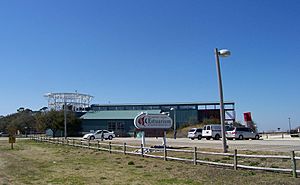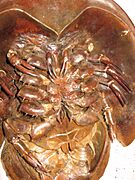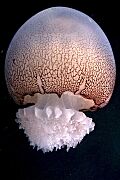Dauphin Island Sea Lab facts for kids
| Date opened | 1971 |
|---|---|
| Location | Dauphin Island, Alabama, United States |
| Coordinates | 30°15′01″N 88°04′43″W / 30.25028°N 88.07861°W |
The Dauphin Island Sea Lab (DISL) is a special place in Alabama where scientists and students learn all about the ocean! It's the main center for marine (ocean) education and research in the state. The Sea Lab started way back in 1971. It's also home to a public aquarium called the George F. Crozier Estuarium, which focuses on animals that live in estuaries (where fresh river water mixes with salty ocean water).
You can find the Sea Lab on the east side of Dauphin Island. It's built on land that used to belong to the United States Air Force. It's also right next to the old Fort Gaines, which is a historic landmark.
Contents
Discover the Alabama Aquarium
The George F. Crozier Estuarium is a big part of the Discovery Hall education program at the Dauphin Island Sea Lab. It has a huge Exhibit Hall, which is about 10,000 square feet, and a Living Marsh Boardwalk where you can explore. The Exhibit Hall has four main areas that show off the amazing water creatures found in different parts of Alabama's coast.
Explore Different Water Habitats
- The Mobile-Tensaw River Delta exhibit shows what life is like in Alabama's largest wetland. Here, you can see animals like the American alligator, different kinds of turtles, and gar fish.
- The Mobile Bay exhibit looks like the legs of the Middle Bay Lighthouse. It's filled with animals that live in the slightly salty (brackish) water of Mobile Bay. You might spot stone crabs, horseshoe crabs, blue crabs, oysters, spadefish, and flounder.
- The Barrier Islands exhibit features saltwater animals that live near Alabama's barrier islands. Look for shrimp, blue crabs, and hermit crabs here.
- The Northern Gulf of Mexico exhibit shows the different ocean communities found in the Northern Gulf of Mexico. This is where you can see cool creatures like octopus, lobsters, eels, seahorses, red snapper, sharks, and jellyfish.
- Rays of the Bay is one of the newest exhibits, opened in March 2013. It's a large touch tank, holding about 6,400 gallons of water! You can gently touch different types of rays and skates that live in the Northern Gulf of Mexico and Mobile Bay. Some of the rays you might meet include the Southern stingray, Cownose ray, and Atlantic stingray.
Marine Mammal Research
The Dauphin Island Sea Lab is also a big center for research. In August 2014, they opened a new research building. This facility, which is about 2,300 square feet, is dedicated to studying marine mammals. The Alabama Marine Mammal Stranding Network (AMMSN) moved into this new building on May 22, 2015. They help animals like dolphins, manatees, and whales that get stranded along the Alabama Gulf Coast.
Gallery
-
Red-eared slider (Trachemys scripta elegans).
-
Atlantic horseshoe crab (Limulus polyphemus).







